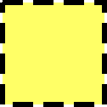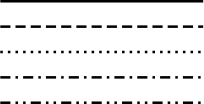Brushes and Pens
Both Text and Path objects are drawn using Brushes and Pens. Brushes control how shapes are filled while Pens control shape outlines.
brush = Brush("#ffff0099")
pen = Pen("000000", Mm(1), PenPattern.DASH)
Path.rect(ORIGIN, None, Mm(20), Mm(20), brush, pen)

Brushes consist of just a color and an optional pattern.
Pens have a color, a thickness, a line pattern, a join style controlling how line joints are drawn, and a cap style controlling how line ends are drawn.
pens = [
Pen(thickness=Mm(0.5), pattern=PenPattern.SOLID),
Pen(thickness=Mm(0.5), pattern=PenPattern.DASH),
Pen(thickness=Mm(0.5), pattern=PenPattern.DOT),
Pen(thickness=Mm(0.5), pattern=PenPattern.DASHDOT),
Pen(thickness=Mm(0.5), pattern=PenPattern.DASHDOTDOT),
]
for i, pen in enumerate(pens):
Path.straight_line((ZERO, Mm(5 * i)), None, (Mm(40), ZERO), pen=pen)

A pen’s thickness controls the overall line thickness measured perpendicular to the drawn line. The true line path always lies in the middle of the drawn stroke. Pens of zero thickness have a special meaning: they are 1 pixel wide regardless of zoom level in interactive views.
Sometimes you don’t want a brush or a pen. This can be done using the special Brush.no_brush() and Pen.no_pen() methods.
Path.rect(ORIGIN, None, Mm(20), Mm(10), Brush.no_brush())
Text((Mm(25), Mm(5)), None, "Outline", brush=Brush.no_brush(), pen="#000000")

In most places where a brush or pen is needed, you can pass in a color string instead for a solid brush or pen of that color.
Path.rect(ORIGIN, None, Mm(20), Mm(10), "#ffff0099", "ff00ff")

Colors
Neoscore supports 8-bit RGBA Colors. You can construct colors explicitly, but in most situations you can pass CSS-style hex strings wherever a Color is needed.
>>> Color('#ff0000')
Color(255, 0, 0, 255)
>>> Color('#ff0000aa')
Color(255, 0, 0, 170)
For those unfamiliar with CSS colors, these values represent red, green, blue, and alpha (transparency) channels, each valued 0-255. The shorthand string is a hexadecimal value where each 2-character group after the hash is a hexadecimal number 0-255.